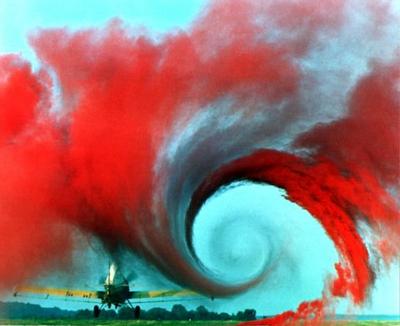http://www.efluids.com/efluids/gallery/gallery_pages/cropduster.htm

On a clear day, trailing vortices are often seen in the sky following the passage of an airplane. The vortices are formed because the wing develops lift. That is, the pressure on the top of the wing is lower than on the bottom, and near the tips of the wing this pressure difference causes the air to move around the edge from the bottom surface to the top. This results in a roll-up of the fluid, which then forms the trailing vortex.
In the sky, the vortex becomes visible when the air has a high humidity. The velocities inside the vortex can be very high, and the pressure is therefore quite low. Water vapor in the air condenses as water droplets, and the droplets mark the presence of the vortex. In this picture of a cropduster flying near the ground, the vortex is made visible by a red flare placed on the ground. The red smoke is wrapped up by the trailing vortex originating near the tip of the wing.
The strength of the vortex is related to the amount of lift generated by the wing, so they become particularly strong in high-lift conditions such as take-off and landing. They also increase in strength with the size of the airplane, since the lift is equal to the weight of the airplane. For a large transport airplane such as a 747, the vortices are strong enough to flip a small airplane if it gets too close. Trailing vortices are therefore the principal reason for the time delay enforced by the FAA between take-offs and landings at airports.
This picture was taken by researchers at NASA Langley Research Center in 1990 (ID # EL-1996-00130).





